Domain Authority: How to Increase Your Ranking Score from Scratch
Updated November 2023.
I’ve run into the same scenario more times than I can count: I start working for a client with a brand new site, we develop an incredible content strategy, and then they ask how long it will take to rank on the first page of Google for high-volume, high-competition terms.
It’s never fun to explain that no matter how great the content and the SEO strategy, we won’t be hitting those top spots for the top keywords for a little while. Not when the site is relatively new, has no content history, and has a limited backlink profile.
New sites naturally have lower domain authorities, which make it harder to compete with established sites that are trusted by and prioritized in search engines. In this post, we’re going to go over everything you need to know about what is domain authority and how to use domain authority, including how to check your current score and how you can improve your score, no matter where you stand.
TABLE OF CONTENTS:
Understanding Domain Authority: The Cornerstone of SEO Success
First of all, let’s get clear on the definition of domain authority (DA).
Domain authority measures the potential ranking strength of an entire domain on search engine result pages. Ranging from 1 to 100, a higher DA score indicates a greater likelihood of a website ranking well.
This predictive metric is based on various factors, with a primary emphasis on the age of the domain and the quality and quantity of backlinks pointing to the domain:

Difference Between Domain Authority and Page Authority
While domain authority assesses the overall strength of an entire domain, Page Authority (PA) evaluates the ranking potential of a specific page within that domain. Both scores range from 1 to 100, but they measure different aspects.
DA considers the collective authority of a website – all its pages and their interconnectedness – while PA focuses solely on the authority of an individual web page.
While a high DA suggests a strong overall website, a high PA indicates a powerful individual page in terms of potential search engine ranking. Both metrics are crucial for understanding and improving a site’s SEO performance.
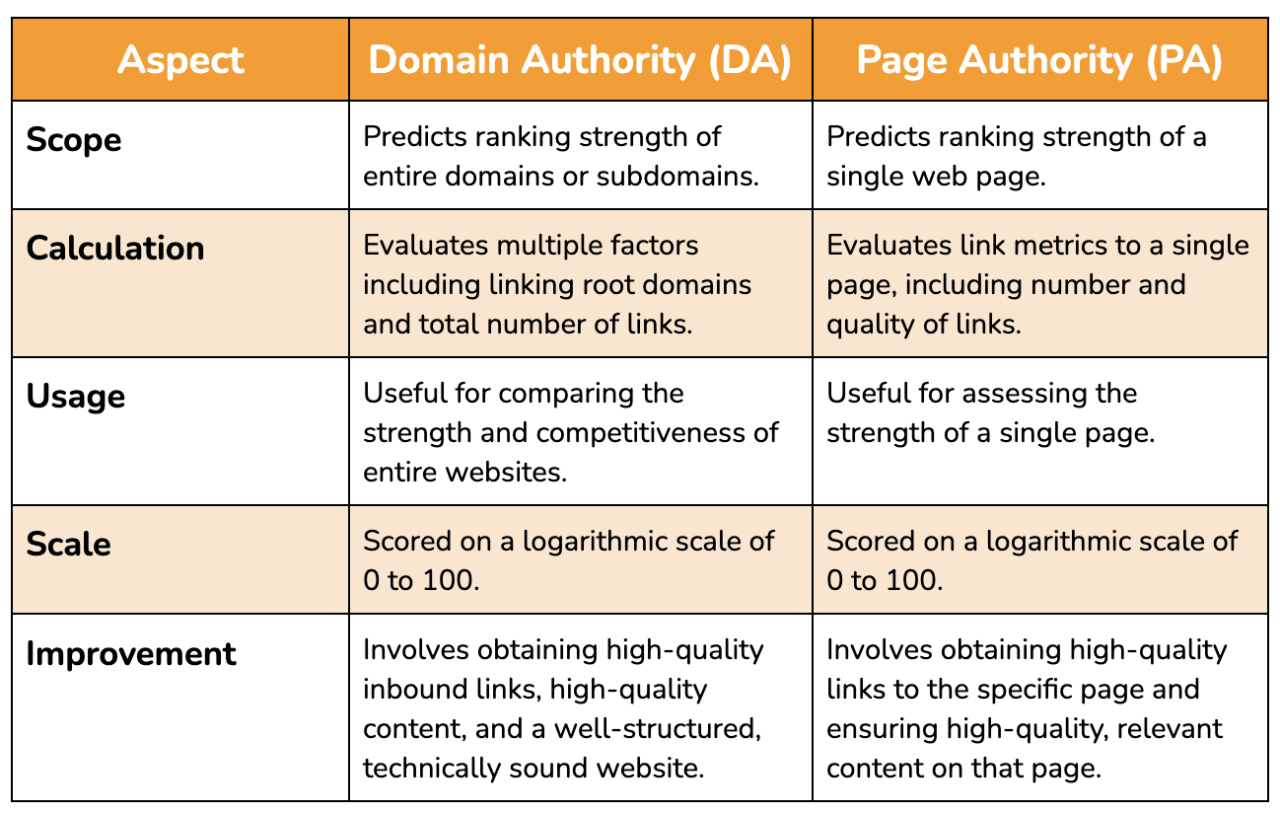
Why Domain Authority Is Important
When someone enters the search term “tips to paint the exterior of my house,” there are tons of relevant pages (well, about 155,000,000, to be specific) that are targeting that keyword phrase, and Google has to decide which page they want to show first.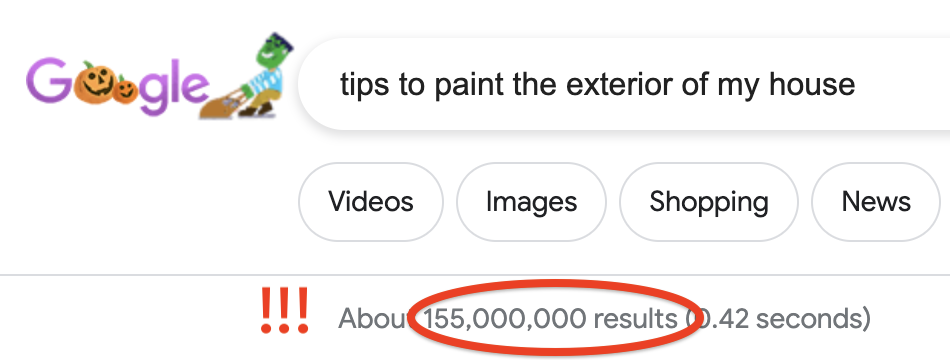
Because the search engine giant wants to increase the likelihood that the user has a great experience, it’ll look for content relevance as well as sites that have a history of producing valuable, trusted high-quality content along those lines.
This is where domain authority comes in. Your brand new mom-and-pop painting company will struggle to compete against a huge chain like Lowes for similar keywords, all else being equal.
Domain authority is not a metric that Google uses when compiling their ranking order for the SERPs, but it is a gauge of how well you can expect to perform against your competitors.
Created by Moz, this metric will give you a number from 1-100 (the higher the score, the better) that tells you how trusted your site is by Google, and therefore how likely you are to rank well.
The Moz Domain Authority Checker is a free software to check the domain authority of any website:

Even though this metric is not an official ranking factor and doesn’t actually affect the SERPs, domain authority is still a good metric to pay attention to because it indicates your potential.
Increasing your domain authority score will often correlate with more potential to do well in the SERPs, though it will have no impact on what your competitors are doing.
Assessing Your Domain’s Standing: Domain Authority Checkers and Metrics
Now let’s dive into the importance of understanding the position of your domain in the digital landscape. Knowing your Domain Authority can provide valuable insights into your website’s competitiveness and potential to rank well in search engine results.
How to Check Your Current Authority Status
There are a number of tools that allow you to check your domain authority for free, but the best ones are Moz’s Domain Authority Checker and the free MozBar Chrome extension.
Both of them give you the domain authority right from the source itself. When you search for a specific URL, you’ll be able to see what your domain authority is;

If your site is newer or hasn’t aggressively worked to build up site links, there’s a good chance that you’ll be hovering around a 30 or less. That’s ok! While it does take time to increase your authority, which is not always fun, there are strategies that can help, and it’s much easier to go from a 30 to a 40 than from a 70 to an 80.
In other words, it gets more difficult the higher you go, which is good news for everyone getting started!
Recommended Domain Authority Checker Tools
Here are the top Domain Authority tracking tools that allow you to observe fluctuations and identify potential areas for improvement in your DA score:
- Moz SEO ToolBar: You need to install the tool on your web browser and then it will automatically display the Domain Authority after calculating the number of linking domains.
- Free Domain Authority Checker: Simply enter any URL whose domain score you wish to check and the tool will quickly share the score.
- Domain Authority Checker From Website SEO Checker: Another great Domain Authority checker that lets you check the DA of any domain by entering the URL in the search bar.
- Bulk Domain Authority Tool From Small SEO Tools: If you wish to check the Domain Authority scores of several domains at once, then this tool is useful. Just enter all the URLs, hit the ‘Check Authority’ button, and it will calculate all the DA scores at once.
Understanding DA Score and Other Relevant Metrics
Understanding a website’s domain authority score is crucial in gauging its potential to rank in search engine results to increase organic traffic.
Complementary metrics such as Page Authority (PA), backlink profile, PageRank, Semrush authority score, Majestic Trust Flow, and user engagement indicators (like bounce rate and dwell time) collectively offer a comprehensive assessment of a site’s online authority, user appeal, and search engine performance.
Regular monitoring and interpretation of these metrics guide strategic improvements for sustained success in the digital landscape.
5 Effective Strategies to Build Your Domain Authority
We know that domain authority, in its own indirect way, is important. I want to stress again that time is a factor that you need to take into account: Older sites are more trusted and naturally have a much more extensive backlink profile, so it will be hard to catch up.
Notice, though, that I said hard and not impossible. I’ve worked with sites over a period of two years that ended up beating out major competitors for those number one spots, so with the right strategies, you can do the same.
Here are the 5 ways you can take action to start building your domain authority as quickly as possible.
1) Master Link Building
Link building is the first thing that you should focus on when it comes to domain authority, because this is a big quality signal that Google looks at. If plenty of other great and high-authority sites are linking to you, after all, it means that they trust you and think you have something to offer.

Google notices this. PageRank assigns a score to each web page based on the number and quality of links pointing to it.
Importance of High-Quality Backlinks
High-quality, relevant backlinks significantly contribute to the improvement of domain authority. These links, particularly from reputable and authoritative sources, serve as a key Google ranking factor, enhancing a website’s overall authority and trustworthiness:
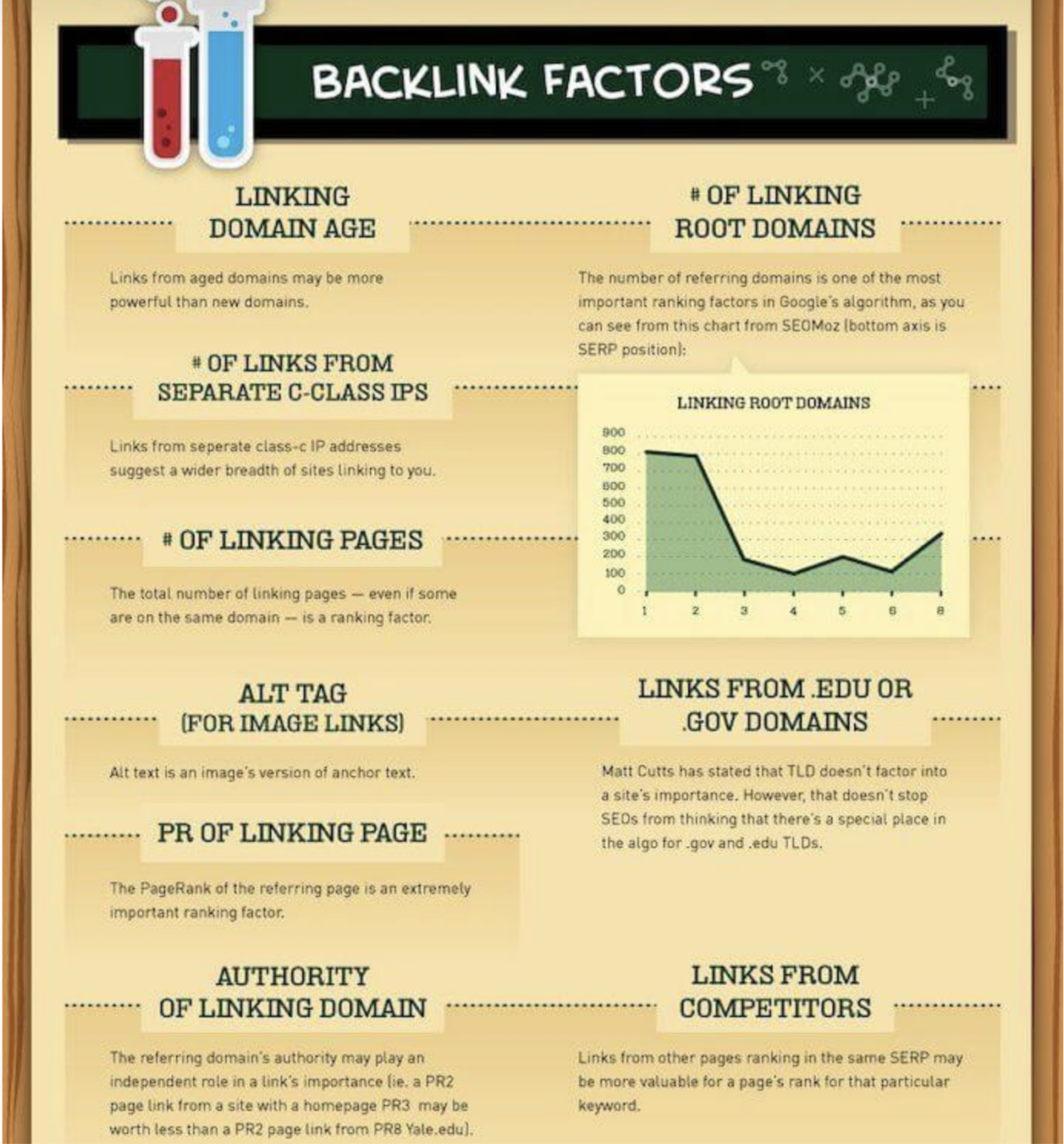
As more quality backlinks are established, a website’s domain authority and domain rating increases, signifying to search engines and users alike that the site is a reliable and valuable resource within its niche. In essence, high-quality backlinks play a pivotal role in elevating and sustaining a website’s domain authority, positively impacting its search engine visibility and online influence.
Run a Backlink Audit
If you haven’t already, the best place to start is to run a backlink audit, which will show you your current backlink profile. It will also flag any potential harmful backlinks you’ll want to remove (which we’ll cover in the next section).

I like Semrush’s backlink audit tool, but there are others that you can using, including Moz.
While looking at your backlink profile, take note of not just how many links you have, but which sites they’re coming from. Check those sites’ domain authorities online: Are any of them high enough to give you a boost? Over 50 is good, but 70+ is outstanding.
As you’re looking at your backlink profile, consider how you can expand upon it. Create quality content on your site through blog posts, because those gives people something that they can link to.
Guest Posting and Outreach Strategies
Guest posting is the best option when you want to build up your domain authority quickly, as it allows you to get backlinks from a number of high-authority sites:

Look for some of the most high-authority publications when choosing your link building profile, and remember that it’s better to have links from four different sites than four links from a single root domain; Google prioritizes the former.
For example, a medical practice would want to find high-domain authority medical sites that share references to the topics the medical practice covers. Linking to and from those resources and sites can help build the credibility of the practice in the eyes of search engines. Another could be a Saas platform wanting to build traffic to its product by way of building a strong backlink profile with other brands online
2) Eliminate Harmful Backlinks
Sometimes it’s easy to get a little overeager with backlink building, especially if your business took part in any of the “not punished then but now not approved” backlink practices. Private blogging networks, for example, will typically hurt your site more than they’ll help, and spamming your link online is a fast way to get a Google penalty and a knock down on your domain authority score.
Identifying and Removing Toxic Backlinks
Use Semrush to toxic backlinks. This tool will flag all the toxic links that you have, showing you the individual backlink, along with your overall ratio of positive-to-toxic links. They’ll also show you the number of linking root domains you’re getting backlinks from, which is helpful to see.

Create a list of backlinks you need to start working on. If you can remove them manually, go back and do so. For example, remove links to your site in the comments sections or forums. If, however, you no longer have access to the sites where your links are placed, which may be the case for something like a private blogging network, then you’ll need to disavow them.
Using Google’s Disavow Tool
A link disavow should only be done if you believe that you have links that are knocking you down and if you haven’t been able to remove them manually. The process is pretty straightforward, and you can learn how to do it here:
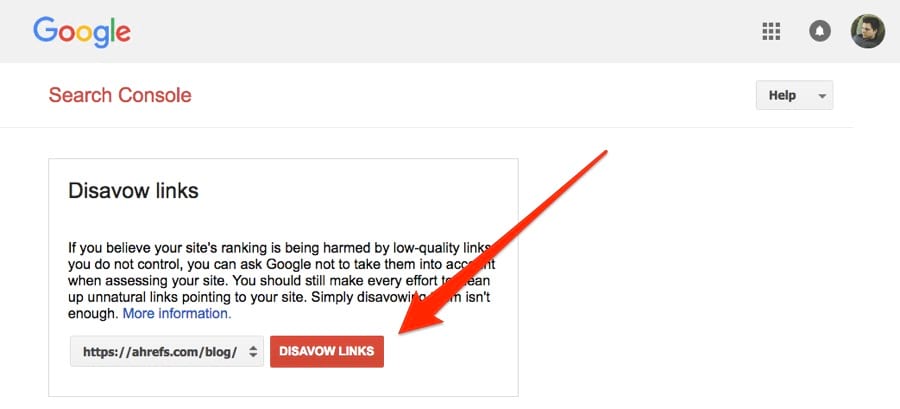
3) Create Great Content That Resonates
Content marketing is going to be a huge asset while you’re trying to build up your domain authority.
This content strategy allows you to keep the main pages on your site in order while still creating new opportunities to write fresh content (which Google loves) that can attract your target audience, provide a valuable avenue for new backlinks, and allow you to rank for more keywords.
Identifying High-Value Content Opportunities
Identifying high-value content opportunities is crucial for creating impactful and relevant material that resonates with your audience.
Understand your target audience’s needs, preferences and pain points. Use tools like surveys, social media insights and analytics to gather data.
Analyze competitors in your industry to identify content gaps. This just means assessing their most successful content and looking for areas where you can provide your own unique and better content. You can use a tool like BuzzSumo to do that. Simply enter your primary keyword and the tool will return a list of content that has received the highest social media shares and engagement.

Moreover, you can evaluate your existing content for gaps and areas of improvement. Using Ahrefs’ Content Gap tool enables simultaneous analysis with multiple competitors, providing an extensive list of keywords that are prime targets for your content strategy. Your job is just to fill these gaps with new, better, comprehensive content.

Implementing Keyword Research and SEO Best Practices
When using content marketing as a core part of your backlink strategy, keep the following in mind:
- Target relevant and high-value keywords: Identify keywords that align with your content and have significant search volume. Focus on terms that are relevant to your audience and industry.
- Prioritize long-tail keywords: Long-tail keywords are more specific and often attract a more targeted audience. Consider user intent and address specific queries with your content:
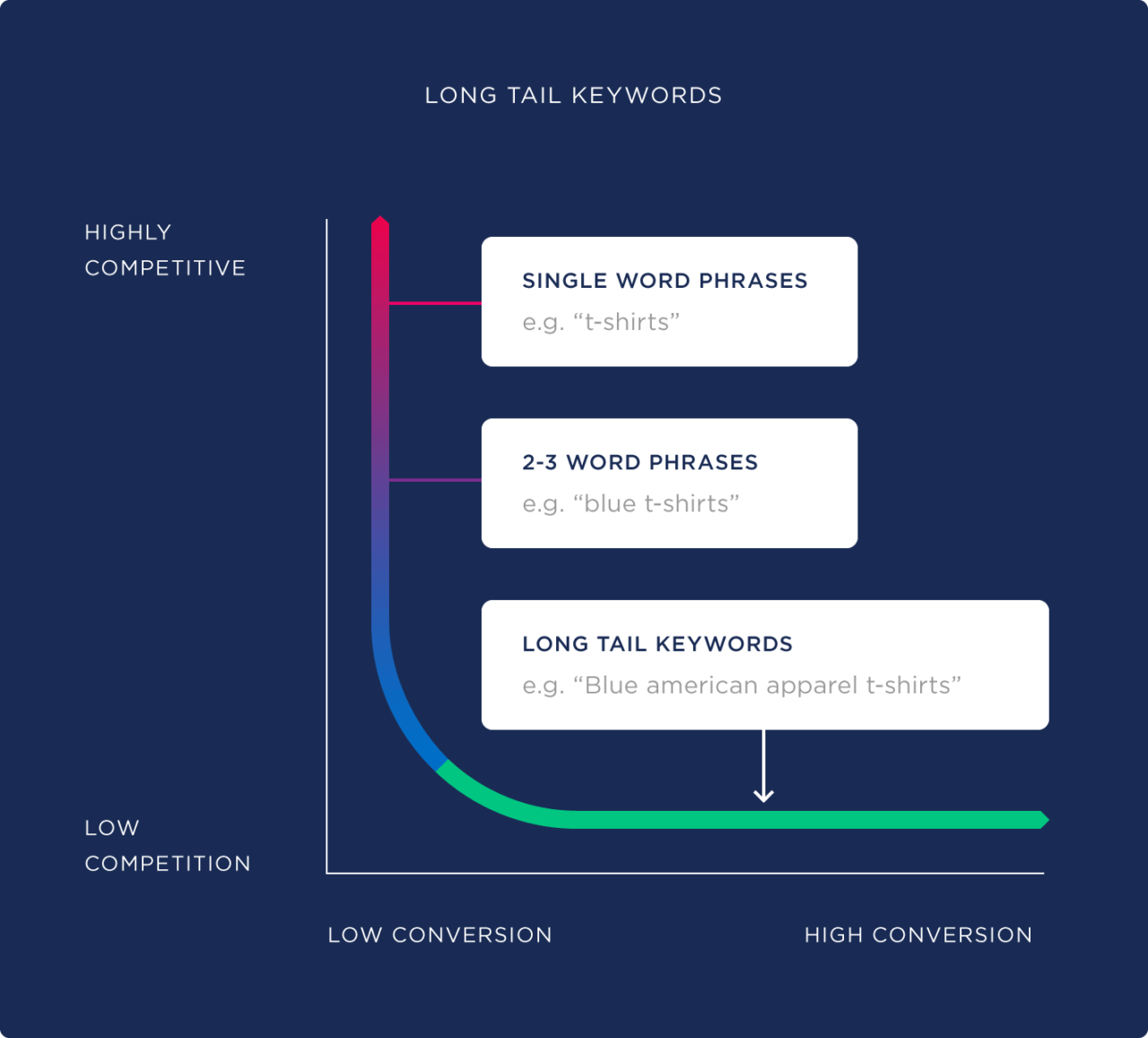
- Design a clean and intuitive website: Create a visually appealing and user-friendly design. Prioritize easy navigation, clear calls to action, and a layout that guides users to relevant information.
- Have a strong distribution plan: If you want to get more eyes on your content, which will get you more shares and more backlinks, you need to have a strong distribution plan in place. If your domain authority isn’t strong yet, you can’t rely on SEO alone; have social campaigns set up to share your posts, and consider reaching out to your network and ask for a few shares at the beginning. You can also use PPC campaigns like Facebook Ads to promote important posts and hopefully gain traction early on.
- Offer unique, original content. If you want those links and a lot of attention on your post, you have to write posts that no one else has done yet. Opt for original thoughts and, if possible, even consider creating resources like infographics or case studies that contain statistics from your own research. People will have to link back to you for this.
4) Addressing Crawlability and Indexability Issues
If Google can’t crawl your site, there’s a good chance that the search engine is missing out on the great content you have to offer, and it will hurt you in the SERPs. There’s also a good chance that Moz will detect the same issues, which will cause your domain authority score to take a hit.
Importance of a Clean, Error-Free Website Structure
A clean and error-free website structure is vital for both user experience and search engine optimization.
An organized layout enhances navigation, reducing bounce rates and fostering a positive user experience. From an SEO perspective, a well-structured site ensures smooth crawlability by search engine bots, improving the chances of all individual pages being indexed.
Additionally, clean structures often lead to more straightforward URL structures and effective internal linking, factors that positively influence search engine ranking score and overall website visibility.
Using SEO Tools to Identify and Fix Crawlability Issues
Crawlability issues are something you want to avoid, because that means not getting all the SEO points you should be getting even if you have all the right elements in place.
Use a site audit SEO tool to regularly monitor your site for any issues that could be causing problems, such as confusing redirects, broken links, and even duplicate content.
Semrush is still my go-to here, but again, Moz is another great option:

These tools will show you the specific errors that could be hurting your SEO potential, and they’ll often have suggestions for how to fix it. In many cases, the errors are relatively easy to fix, especially considering the huge payoff that you could get in return.
5) Use Social Media to Enhance Domain Authority
Effectively using social media is instrumental in enhancing domain authority by expanding digital presence and engagement. Actively share your website content on social platforms regularly to amplify reach.
Building a community around your brand fosters social signals that indirectly influence search engine rankings. Include social sharing buttons on every page of your site to make it super easy for readers to share your content, potentially leading to increased visibility and backlinks (scroll down to the bottom of this page – you’ll these buttons!):

Encouraging brand mentions and participating in relevant conversations on social media further establishes online authority, contributing positively to your website’s overall DA.
Encouraging Social Sharing and Interaction
Google and Moz both look at social signals like retweets, likes and shares of your content when evaluating domain and page authority. This ranking factor does not weigh as heavily as other things like backlink profiles or crawlability perfection, but it can make an impact, so if you want to change your domain authority score as quickly as possible, take some time to get this right.
Find ways to increase social proof on your content, as this will get more search traffic to your site and boost your authority score at the same time, both of which will only benefit your business.
Social is a huge driver of online traffic, and if your domain authority is struggling but you’ve started to gain a social following, you can use the latter to help you get more traction with the former.
Make sure that you’re sharing blog posts, infographics and lead magnets with interesting descriptions explaining why users should click to read, instead of just posting the title and hoping that will be enough. Make the value clear up front and include a CTA like: “This e-book is free! Download it now!” to increase clicks on the post and further actions.
Monitoring Progress: Tracking Domain Authority Over Time
Effective SEO strategies require continuous assessment, and tracking Domain Authority over time is a pivotal element in gauging your website’s online authority. Regularly monitoring changes in your DA provides insights into the impact of your SEO efforts and helps you adapt strategies for optimal performance.
Utilizing Domain Authority Trackers
Leverage a specialized domain checker designed to track and report on Domain Authority changes.
Tools that we mentioned above like Moz Authority Checker and Moz ToolBar provide valuable insights into your website’s DA trends, allowing you to track changes over time. These trackers analyze factors such as backlink quality and quantity, helping you gauge the impact of your link-building strategies.
Regularly monitoring your DA with these tools allows you to adapt your SEO efforts, identify areas for improvement, and stay informed about your website’s overall authority in the online landscape.
Analyzing and Adapting Your SEO Strategies
Analyze the factors influencing your DA trends and adapt your SEO strategies accordingly.
Focus on enhancing the quality and relevance of your content, building high-quality backlinks, and ensuring technical SEO aspects are optimized.
Regularly revisit and adjust your approach based on the data provided by domain authority trackers, aligning your efforts with the evolving landscape of search engine algorithms.
Consistent monitoring, coupled with strategic adjustments, empowers you to maintain and improve your website’s authority, ultimately contributing to sustained SEO success.
Final Word on Domain Authority
Domain authority can frustrate a lot of new sites trying to make a name for themselves (and increase site traffic and lead generation) through content marketing, but it’s something that everyone has experienced. Be patient, because a combination of time and some dedication to your link-building strategies will help your website authority, and it will be easier for you to rank well.
Consistency is important, so keep at these strategies even if it feels like you’re spending too much time waiting on editors to respond to your guest posting inquiries. In the meantime, you can always target some lower-competition long-tail keywords so that you can still rank and start getting some of those clicks to your site.
If you’re ready to see measurable increases in organic traffic and boost your DA, Single Grain’s SEO experts can help!👇
Additional content contributed by Joydeep Bhattacharya.
Domain Authority FAQs
-
What is the domain authority?
SEO domain authority, simply referred to as the DA is an SEO metric developed by Moz that predicts the reputation of a domain and the chances of how well the website can rank on search engine result pages (SERPs).
It is a score that ranges from 1 to 100, with higher scores correlating with higher organic rankings. Domain authority considers various factors, such as the number of linking referring domains and the quality of those inbound links, to assess the overall authority of a website.
-
What is domain authority with an example?
If a website has a high-quality backlink profile with links from reputable and authoritative sites, and it consistently produces valuable content, its domain authority is likely to be high. Conversely, a website with fewer quality backlinks and less relevant content may have a lower Domain Authority.
For instance, Single Grain has a domain authority of 65, meaning it has a higher than average DA. You can check DA with the help of the free Domain Authority checker tool by Moz.
-
What should my domain authority be?
Your domain authority should be above average to get the most benefit. Here are the different domain authority scores range:
- 0 to 10: Very low
- 10 to 20: Low
- 20 to 30: Below average
- 30 to 40: Average
- 40 to 50: Above average
- 50 to 60: Good
- 60 to 70: Strong
- 70 to 80: Very strong
- 80 to 90: Excellent
- 90 to 100: Outstanding
It’s important to note that these ranges are general guidelines, and what is considered “good” or “excellent” can depend on your specific industry and the competitiveness of your niche.
-
Is 20 a good Domain Authority score?
A domain authority (DA) score of 20 is considered relatively low on the scale of 1 to 100. A DA of 20 suggests there is room for improvement in terms of your website’s authority and potential to rank higher in Google search results.
-
Is domain authority the only factor that determines search engine rankings?
No, domain authority is just one of many factors that search engines consider when determining rankings. Content quality, relevance, user experience, and other SEO factors also play crucial roles.
-
Can a new website have a high domain authority?
It’s unlikely for a new website to have a high domain authority immediately. DA often grows over time as the website establishes a credible online presence and acquires quality backlinks.
-
How long does it take to increase domain authority?
Increasing Domain Authority is a gradual process and can take several months to years. It depends on factors such as the website’s current authority, the consistency and quality of content creation, and the acquisition of high-quality backlinks.
-
How can I increase domain authority?
To increase your website’s domain authority, focus on producing high-quality, relevant content that attracts natural backlinks from reputable websites. Optimize on-page SEO elements, implement a strategic internal linking strategy, and ensure your website is technically sound. Consistency in these efforts, along with building a strong online presence, will contribute to a gradual improvement in your domain authority over time.




